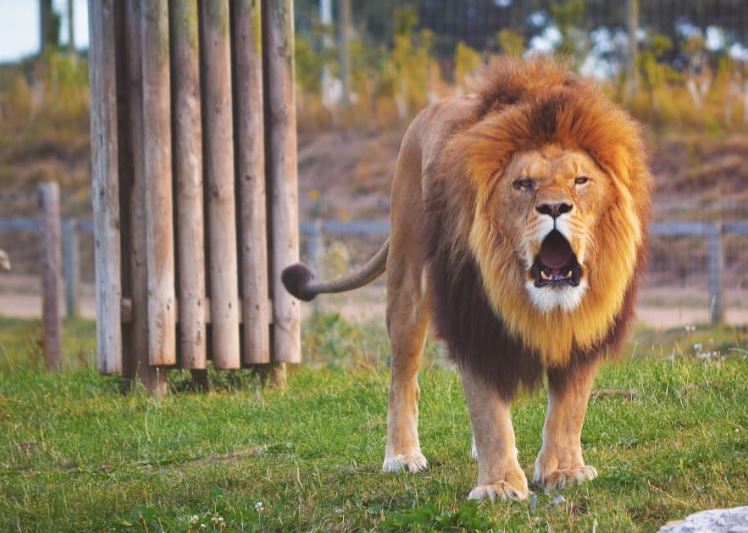 Most people are familiar with lions’ vocalizations from watching the MGM movies that always start with Leo the Lion roaring. Roaring is vital to a lion’s communication, displaying its strength and territory.
Most people are familiar with lions’ vocalizations from watching the MGM movies that always start with Leo the Lion roaring. Roaring is vital to a lion’s communication, displaying its strength and territory.
Research shows that lions can distinguish their roar from others and conduct mental head counts of other pride members. This allows them to gauge the strength of a challenge before engaging in battle.
Lead by example.
Few things compare to the prickle of goosebumps that run down your back and the racing of your heart when you hear a lion roaring in the wild. Screaming allows male lions to advertise their territory and remind other lions of their dominance.
They also use roars to communicate within their pride and coalitions. Roaring can reach up to 114 decibels—as loud as some rock concerts!
Take initiative.
You can learn a lot from this lion president book, where taking the initiative is critical to being a good leader. This means being proactive rather than reactive and seeing opportunities where others don’t.
Taking the initiative can feel like extra work, but it’s a short-term pain for long-term gain. It helps to communicate that to your team and seek feedback on their efforts. Getting rid of bottlenecks that prevent taking initiative is also helpful.
Communicate.
Clear communication is essential in any leadership role, whether face-to-face, on the phone, or via email. Encourage your team to use clear, jargon-free language when discussing projects or ideas.
The Lion King teaches us that leadership is less about title and more about action. It’s about being a role model for others. Be bold in proclaiming your beliefs.
Take risks.
Leadership is about taking risks and trying new things. It can be helpful to consult with experts on the topic before taking a risk, but ultimately, leaders must make decisions based on their strengths and limitations.
The Swedish sisters of First Aid Kit draw Fleet Foxes comparisons with their dense echo-chamber harmonies, but the songs on their latest album, The Lion’s Roar, are much more severe.
Be flexible.
Flexible leadership starts with cognitive flexibility, which involves agile thinking and a propensity to learn. It also includes emotional flexibility, which can vary one’s response to social cues.
Practice listening to your team members to understand their needs and perspectives. It’s also essential to consult with them on how they feel about current projects and operations. A healthy, flexible leader can adapt and evolve with their team.
Be accountable.
Accountable leaders have a strong sense of responsibility and are willing to tackle complex issues. They are also supportive of their teams when faced with adversity.
Leaders must be able to admit their mistakes and work through them quickly. They must also give employees a voice and encourage them to share their ideas and concerns with leadership. A culture of accountability can foster a sense of ownership and improve business outcomes.
Be honest.
Honesty is crucial to building trust with your team. It also helps you keep your goals in sight.
Honest leaders can acknowledge their mistakes and use them as opportunities for growth. They also know how to ask for feedback from their teammates.
Being honest can be difficult, but it’s essential for leadership. Leaders who are honest with their teams have greater trust and respect from them.
Be creative.
Leaders who encourage team creativity can benefit from a more open culture. This can include facilitating cross-functional collaborations and incorporating new ideas into existing projects.
Lions protect their territory and their young, and this same characteristic is essential for leaders. Defensive leadership can prevent creativity from stalling by balancing risk-taking and maintaining the status quo.
Be flexible.
Flexibility is a leadership characteristic that requires self-awareness, open-mindedness, and intentional practice. Leaders can cultivate flexibility by seeking feedback from others, immersing themselves in new environments and situations, and proactively incorporating flexible behavior into their leadership style.
First Aid Kit’s “The Lion’s Roar” offers a good-natured clap-along folk anthem to celebrate the joy of change. A ramshackle, playful energy balances its stark moments.
Be humble.
When leaders exhibit humility, they show their teams that they care more about people than themselves. Humble leaders find joy in the accomplishments of others and refrain from relating their successes to those of their friends and colleagues.
This enables them to connect with their team members more profoundly and build trust. Humble leaders also admit their weaknesses and seek help when needed.
